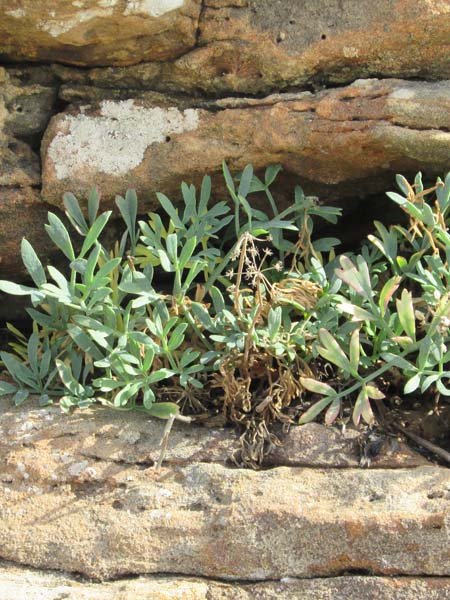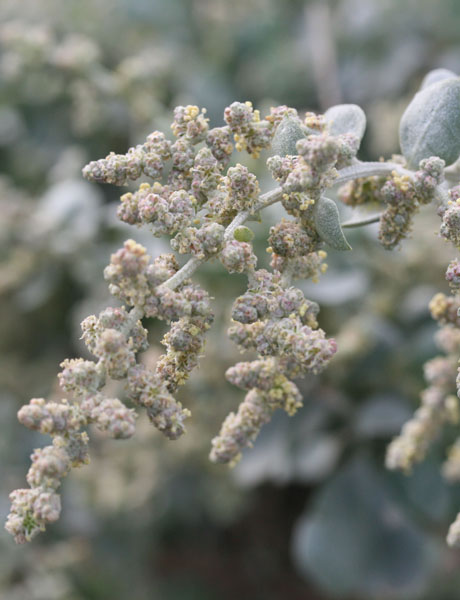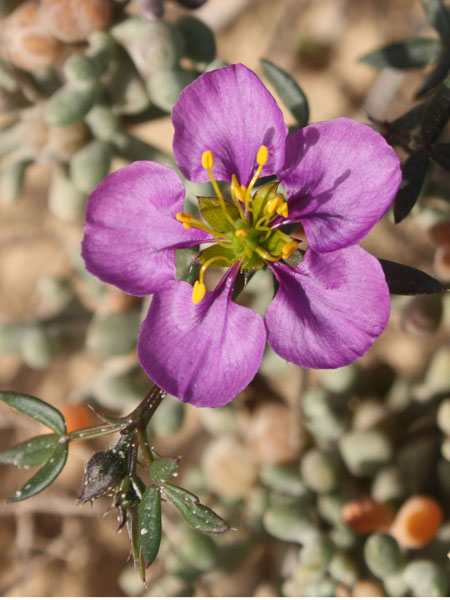Eryngium maritimum
Kingdom : Plantae / النّباتات
Division : Spermaphyta / البذريات
Clade : Magnoliophyta or Angiospermae / مستورات البذور
Class : Eudicotyledoneae / ذات الفلقتين
Order : Apiales / رتبة الخيميات
Family : Apiaceae [Umbelliferae] /الفصيلة الكرفسيّة
Genus : Eryngium
species : maritimum
Chromosomes: 2n=16
Protologue
L., Sp. Pl., ed. 1, 233 (1753)
Common names
Tunisia Arabic English French Tamazight
شوك الذّيب
القِرصَعنة البحريّة
البهشيّة البحريّة
Sea holly
Seaside eryngo
Sea holme
Panicaut maritime
Panicaut des dunes
chardon bleu des dunes
Toxic
no
Edible
no
Latex
no
Botanic description
Genus description
"Hairless plants. Thorny leaves, thistle port. Sessile flowers in tight involucral capitula, on a receptacle globular or cylindrical, each in the axil of a bract (straw). Chalice with 5 thorny teeth at the top. Petals connivents, more short, with an inflected point within. Obovoid fruit with scales with suborbicular cross section. Mericarpes without ribs nor strips, welded along their length to the carpophore.
Species description
"Spiny plant with herbaceous thistle, rigid glaucous, a little bluish, rhizome emitting discharges of height ranging from 30 to 60 cm. The root system can be very long: the taproot ensures a strong anchorage against the wind.
Stems 30-60 cm, glabrous branching, striated and erect. Leaves coriaceous and spiny palm-lobed, with spreading lobes, toothed-spiny, strongly nerved. Flowers bluish in flower heads peduncles of the size of a small walnut. Inflorescence rounded capitulums of globular form, umbellules umbel and involucre of bracts. Fruits ovoid, tuberculous
Botanic References
Pottier-Alapetite G. (1981). Flore de la Tunisie Angiospermes –Dicotylédones (Apétales- Dialypétale , Première partie). Imprimerie Officielle de la République Tunisienne (Eds),467 p. Edouard LE FLOC’H, Loutfy BOULOS et Errol VELA. (2010). Catalogue synonymique commenté de la FLORE DE TUNISIE. République Tunisienne, Ministère de l’Environnement et du développement durable, Banque Nationale de Gènes. 500 p www.theplantlist.org
Biology
Life form Perennial Type form Therophyte Photosynthesis C3
Phenology
Blooming
JanuaryFebruaryMarchAprilMayJuneJulyAugustSeptemberOctoberNovemberDecember
Fruiting
JanuaryFebruaryMarchAprilMayJuneJulyAugustSeptemberOctoberNovemberDecember
Map Localization
Ecology
Adaptation This psammophyte grows on the coasts of the Mediterranean on sandy soils. It is found on the dunes and pebble areas of the coast. They must adapt to salt water, wind and spray. Salt bladder yes Invasive no
Geographical distribution
Localization Biocimatic stage Annuel pluviometry (mm) GPS Monastir (Bekalta, Juillet 2015) Inferior semi-arid 331 35°36'33.77"N / 11° 2'41.89"E Sousse (Hergla, Août 2016) Inferior semi-arid 331 36° 2'13.97"N / 10°29'45.03"E Cap Bon (Tazeka, Fév. 2016) Superior semi-arid 444 36°32'22.41"N / 10°50'55.08"E Cap Bon (Korba, Mars 2014) Superior semi-arid 444 36°35'1.62"N / 10°52'24.52"E Bizerte (Rimel, Déc. 2014) Lower humid - sub-humid 653 37°15'29.15"N / 9°54'13.30"E
General uses
The boiled and roasted roots have a taste that reminds of chestnuts.
Medicinal uses
"Sea holly has been widely-used for its restorative and aphrodisiac properties mainly. The plant is always used for its diuretic action. The root promotes free sputum and is very useful in the treatment of chronic coughs as well as in the treatment of cystitis, urethritis, and as a means of relieving kidney stones. It probably does not dissolve these but delays training. It can also be used to treat enlargement or inflammation of the prostate. Taken as an infusion, it is used to treat diseases of the liver and kidneys. It also allows tissue regeneration when used as a poultice. The roots of 2-year -old plants must be harvested in autum. In England, the root of the sea holly used to be eaten as candy. In addition to that it help to prevent scurvy. It was also effective in treating some neurological disorders such as paralysis and convulsions. Sea holly treats and heals respiratory disorders, too.
NOTE : This website is not that of herbal medicine and assumes no responsibility for the negative effects of the use of plants. Seek advice from a professional before using a medicinal plant.
Systems / Organs / Effects
Digestive System Reproductive System Nervous System Urinary System Respiratory System Mouth / Teeth Stimulant Diaphoretic
Test results
TPC DPPH ABTS+ FRAP Year mg GAE g-1 MS CI50 g ml-1 CI50 g ml-1 CE50 g ml-1 22,12± 1,55 74,66± 9,22 145,16± 2,34 673,06± 15,77 2016 Total Phenols content(TPC), Anti-radical potentialities against (DPPH, ABTS), Ferric reducing antioxidant power(FRAP)
Molecules : ADN / Proteins
Chromosomes : 16 Uniprot NCBI
Tunisian references
Other references
Clausing G, Vickers K & Kadereit JW. (2000). Historical biogeography in a linear system: genetic variation of Sea Rocket (Cakile maritima) and Sea Holly (Eryngium maritimum) along European coasts. Mol. Ecol. 9: 1823-1833. Kholkhal W, Ilias F, Bekhechi C, Atik Bekkara F. (2012). Eryngium maritimum: A Rich Medicinal Plant of Polyphenols and Flavonoids Compounds with Antioxidant, Antibacterial and Antifungal Activities Current Research Journal of Biological Sciences . 4(4): 437-443 109. Thiem B, Goliska O, Kikowska M, Budzianowski J. (2010). Antimicrobial activity of three Eryngium L. species (Apiaceae). Herba Polinica . Vol. 56 No. 4 Küpeli E, Kartal M, Aslan S, Yesilada E.(2006). Comparative evaluation of the antiinflammatory and antinociceptive activity of Turkish Eryngium species. J. Ethnopharmacol. 2006; 107, 1, 32-37. Suciu S. and Pârvu A.E., 2012. Comparative study on the effects of Eryngium sp. extracts in an acute inflammation model in rat. Annals of RSCB. 2012; 17, 86.






























